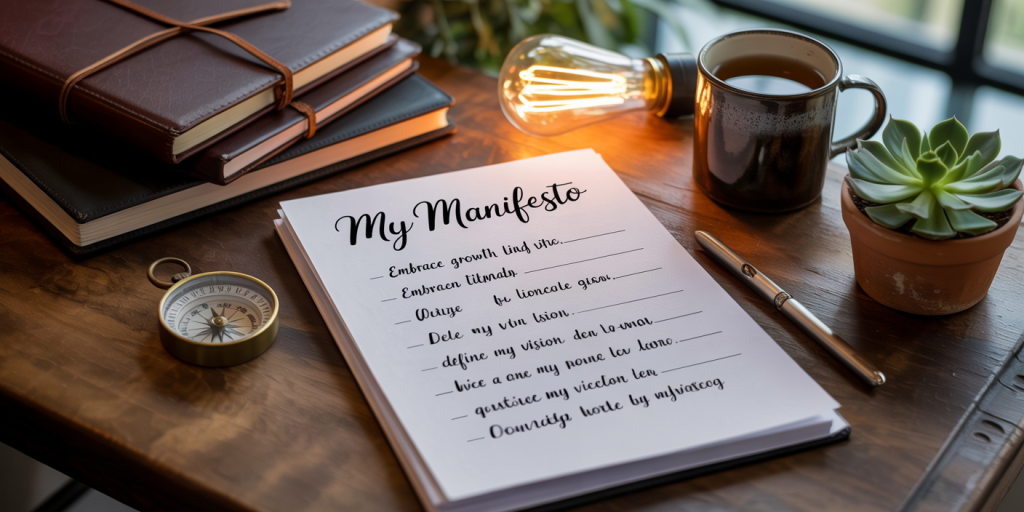How to Create a Personal Manifesto for Decision Clarity
In today’s fast-paced world, decision-making can often feel overwhelming, especially when faced with numerous options and conflicting priorities. Many individuals struggle with uncertainty, procrastination, or regret due to indecisiveness. One powerful tool that can transform this experience is a personal manifesto. A personal manifesto serves as a guiding document that outlines your core values, beliefs, and goals, empowering you with clarity in decision-making and fostering consistency in choices. This article explores the step-by-step process of creating a personal manifesto and how it can be instrumental in enhancing decision clarity.

Understanding the Value of a Personal Manifesto
A personal manifesto acts as a compass, helping individuals stay focused on what truly matters. Unlike general goal-setting, which often emphasizes outcomes, a manifesto emphasizes the “why” and “how” of your life approach. It distills your priorities into a structured framework, clarifying what should influence your daily decisions and long-term plans.
Studies have repeatedly highlighted the link between clarity of goals and improved decision-making. Research by Locke and Latham (2002) demonstrated that clear goals lead to enhanced performance and motivation. Similarly, a manifesto designed around your authentic values can reduce cognitive dissonance—the mental discomfort arising from conflicting beliefs or actions—by aligning decisions with your personal truth. For example, if integrity is a core value in your manifesto, you’ll naturally avoid choices that compromise honesty, resulting in clearer, more confident decisions.
Crafting Your Core Values: The Foundation of Your Manifesto
The first step when creating a personal manifesto is to identify your core values. These are the fundamental beliefs that shape your behavior, priorities, and reactions to various situations. Begin by reflecting on moments in your life when you felt most fulfilled or proud; these can offer clues about your values.
To further clarify, consider values such as integrity, creativity, compassion, freedom, or discipline. Use introspective questions like, “What principles am I unwilling to compromise?” or “What traits do I admire most in others?” Listing around 5-7 core values helps focus your manifesto without overwhelming it.

A practical approach involves ranking these values in order of importance. For example, a young entrepreneur may prioritize innovation and resilience over comfort and security, while a social worker might place empathy and service above personal gain. This ranking will clarify decision priorities when conflicts arise.
| Value | Example in Decision-Making | Impact on Choices |
|---|---|---|
| Integrity | Refusing to cut corners in business deals | Builds trust, ensures transparency |
| Freedom | Choosing a career with flexible hours | Enables lifestyle balance |
| Compassion | Volunteering time or resources | Enhances social contribution |
| Discipline | Maintaining a strict daily routine | Supports goal achievement |
By being intentional about these values, your manifesto serves as a touchstone for both major life decisions and everyday dilemmas.
Writing Statements That Reflect Your Beliefs
Once you’ve distilled your core values, the next phase involves articulating them in the form of personal statements or affirmations. These should be clear, concise declarations that represent how you intend to live in alignment with your values.
For instance, instead of a vague statement like “I want to be kind,” write “I commit to practicing empathy by actively listening and responding thoughtfully to others.” Specificity ensures that your manifesto is actionable rather than abstract.
Real-world examples can be highly motivating. Take the example of author and speaker Brené Brown, who has a manifesto rooted in vulnerability and courage, famously stating: “I will choose courage over comfort.” Such declarations provide a firm foundation in moments of uncertainty or fear.
When writing your personal statements, keep these guidelines in mind: Use present tense to ground your manifesto in action. Keep language positive and empowering. Make statements measurable or observable if possible. Ensure they resonate on an emotional level.
These statements become criteria to evaluate decisions. When faced with a choice, asking “Does this align with my commitment to [value]?” simplifies complicated situations and reduces hesitation.
Incorporating Long-Term Goals and Vision
While values and beliefs anchor your manifesto, including a long-term vision contextualizes your decisions in the bigger picture. Defining where you want to be in 5, 10, or 20 years guides prioritization and resource allocation.
Consider well-known figures like Oprah Winfrey, who has famously crafted a vision of empowering others through media and education. Her clear vision drives deliberate choices regarding projects and partnerships, fostering consistency and direction.
To integrate vision into your manifesto, describe both professional and personal aspirations that reflect your values. For example, “I envision myself leading a nonprofit organization that supports mental health awareness within the next decade,” aligns purpose with practical goals.
According to a 2020 Gallup poll, people with clear long-term goals report 42% higher satisfaction in decision-making and life fulfillment. Having this broader vision included in your manifesto helps maintain momentum during challenging times and prevents distractions from short-term temptations.
Using Your Personal Manifesto for Everyday Decision-Making
The real power of a manifesto lies in its application during daily choices, big or small. When you face a question such as whether to take a new job, pursue further education, or even how to spend free time, referencing your manifesto can streamline the process.
For instance, if your manifesto includes a commitment to health and well-being, a decision to skip exercise becomes easier to evaluate and likely less frequent. Or if your values emphasize lifelong learning, you may consistently prioritize courses, books, and intellectual challenges over passive entertainment.
Let’s analyze two decision scenarios side-by-side to illustrate how a manifesto aids clarity:
| Decision Scenario | Without Manifesto | With Manifesto |
|---|---|---|
| Accepting a high-paying but unethical job offer | Ambivalence, prolonged deliberation, or regret | Immediate evaluation based on integrity focus; likely refusal |
| Choosing weekend activity | Random selection, possible guilt or dissatisfaction | Activity aligned with value of family or relaxation, leading to fulfillment |
This approach not only saves time but also builds self-trust by reinforcing your identity through actions.
Future Perspectives: Evolving Your Manifesto with Growth
A personal manifesto is not a static document; it should evolve as you gain new experiences, insights, and goals. Periodic review, perhaps annually or biannually, ensures that your manifesto reflects your authentic self and current realities.
Consider the example of Malala Yousafzai, whose values and vision expanded as she transitioned from a local advocate to an international symbol for education rights. Adapting her personal beliefs in response to life’s trajectory strengthened her decision clarity and impact.
Moreover, the ongoing digitalization of personal growth tools presents exciting prospects for manifesto creation. Interactive apps, AI coaching, and virtual journaling platforms offer real-time prompts to align decisions with your manifesto, making clarity more accessible and integrated into daily routines.
Research from the University of Pennsylvania in 2023 underscores the benefit of adaptive personal frameworks, showing that individuals who actively revise their guiding principles experience 30% higher emotional resilience during transitions.
In summary, the journey of crafting and living by a personal manifesto opens pathways to not just clearer decisions but also deeper self-awareness and life satisfaction. By grounding your choices in authentic values, articulating concrete commitments, and envisioning your future, you can navigate ambiguity with greater confidence and purpose. Whether you are a student, professional, artist, or entrepreneur, investing time in this reflective process promises long-term dividends in both personal and professional realms.

